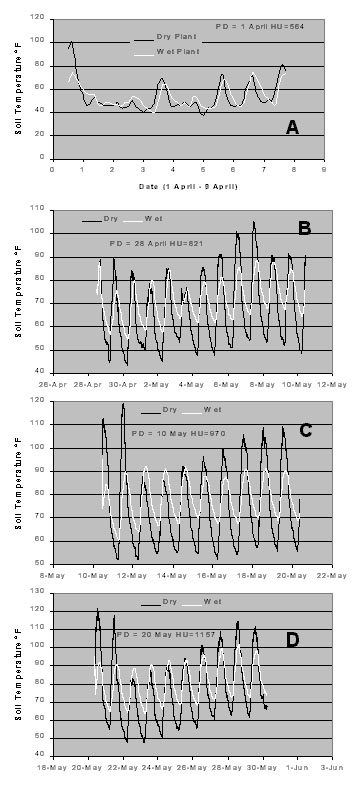Both wet and dry planting methods are commonly used in the cotton producing regions of the desert Southwest. In a dry plant situation, seeds are commonly placed at a very shallow depth in the soil, with a very thin layer of soil covering the tops of the seeds. Thus, seeds planted into dry soil and subsequently "watered-up" are directly exposed to the soil surface and atmospheric conditions. Seeds that are planted into moisture (wet planting) are commonly placed in a seed line one to two inches below the soil surface, depending on soil conditions and depth to adequate soil moisture. In desert cotton production, it is common to cover seeds planted into moisture with a "cap" or layer of soil approximately six to eight inches deep to serve as a dry mulch or insulating layer above the seedline. Many questions commonly arise regarding the pros and cons associated with these two planting techniques, particularly in terms of temperature effects on the seeds.
A set of studies were conducted in 1999 at the University of Arizona Marana Agricultural Center to compare the effects of both dry and wet planting techniques on the soil temperatures at the depth of seeding and subsequent plant growth, development, and yield. The differences in soil temperature at the depth of seeding for both the dry and wet planting techniques are shown in Figures 1A - 1D. The dates of planting and accumulated heat units (HU) from 1 January for each date are also shown. Figure 1A is for a 1 April planting date that was ultimately abandoned due to poor stands and very poor seedling vigor following a strong cold front (with rain and snow) that hit the area on 2 - 4 April 1999. In that case, soils were saturated for both planting techniques due to rainfall and one can easily see the extent of cold temperature stress that the seeds were exposed to.
Figures 1B-1D describe the temperature regimes associated with both the wet and dry planting techniques for three subsequent planting dates. It was found that either technique can be used to produce favorable stands and yields. However, seeds planted shallow with a dry plant method are subject to wide fluctuations in temperature, following very closely the diurnal shifts in air temperature. These temperature ranges can commonly involve changes of 40 ° F in one day, which can result in a greater potential for seedling stress in a dry plant situation if air temperatures drop significantly. In the first few days following a water-up irrigation, while soils are still wet, the average soil temperature in the dry plant situation is usually slightly lower than in a wet planting.
Thus, there is more risk associated with a dry planting operation and watering-up in terms of cold temperature stress on the seeds in the event of cold weather. It is also important to note that seedlings are often considered to be most sensitive to cold stress during the first few days of germination. Accordingly, this information reinforces the common recommendations to carefully consider the five-day weather forecast prior to planting.
Figures 1A-1D. Soil temperature responses at the depth of seeding for dry and wet planting conditions at four dates of planting, Marana, AZ, 1999.
Issued in furtherance of Cooperative Extension work, acts of May 8 and June 30, 1914, in cooperation with the U.S. Department of Agriculture, James A. Christenson, Director Cooperative Extension, College of Agriculture and Life Sciences, The University of Arizona.
The University of Arizona is an equal opportunity, affirmative action institution. The University does not discriminate on the basis of race, color, religion, sex, national origin, age, disability, veteran status, or sexual orientation in its programs and activities.
Any products, services, or organizations that are
mentioned, shown, or indirectly implied in this web document do not imply
endorsement by The University of Arizona.
Information provided by Jeffrey C. Silvertooth, silver@ag.arizona.edu
Extension Agronomist - Cotton, College of Agriculture, The University of Arizona.
Material written 28 January 2000.
Home | Cotton | Advisories
document located at: http://cals.arizona.edu/crops/cotton/comments/jan2000cc.html
Copyright © 2001 University of Arizona,
College of Agriculture and Life Sciences
Webmaster: Al Fournier (acis@ag.arizona.edu)
